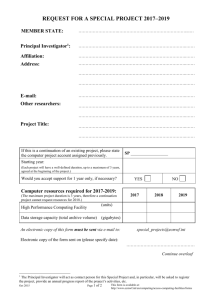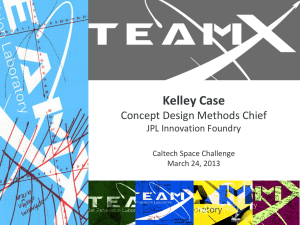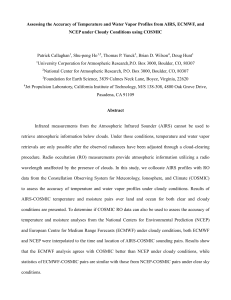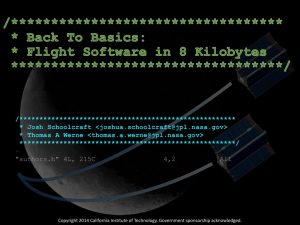The Validation of AIRS Retrievals
advertisement
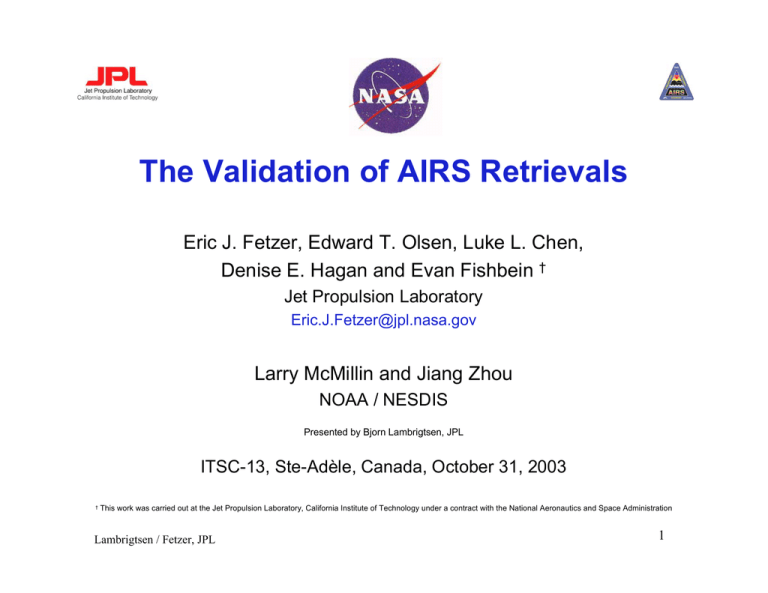
The Validation of AIRS Retrievals Eric J. Fetzer, Edward T. Olsen, Luke L. Chen, Denise E. Hagan and Evan Fishbein † Jet Propulsion Laboratory Eric.J.Fetzer@jpl.nasa.gov Larry McMillin and Jiang Zhou NOAA / NESDIS Presented by Bjorn Lambrigtsen, JPL ITSC-13, Ste-Adèle, Canada, October 31, 2003 † This work was carried out at the Jet Propulsion Laboratory, California Institute of Technology under a contract with the National Aeronautics and Space Administration Lambrigtsen / Fetzer, JPL 1 Outline: August Data Release & New Results • Public Data Release in August: Oceans between 40°S and 40°N – Further restricted so retrieved sea surface temperatures (SST) agree with NCEP forecast within ±3 K • a simple, temporary substitute for self-consistent indicators • recent analyses show this is not a perfect quality indicator • internal quality indicators are under development – Validated Quantities: • SST – ECMWF model, buoys, shipborne spectrometer • Temperature profiles (T) – ECMWF, sondes • Water vapor profiles (q) – ECMWF, sondes • Exploratory Analyses: Some preliminary results Lambrigtsen / Fetzer, JPL 2 The AIRS / AMSU / HSB Retrieval System • Utilizes a combination of infrared and microwave observations – – – – AIRS: 2378 IR channels, 15 km horizontal resolution HSB: 4 MW channels, 15 km horizontal resolution AMSU: 15 MW channels, 50 km horizontal resolution Vis/NIR: 4 channels, 2 km resolution (daytime-only diagnostics) • Each retrieval uses 9 AIRS spectra, 9 HSB spectra, 1 AMSU spectrum • Invert these radiances to geophysical quantities of cloud cleared radiance, T and q profiles, cloud properties, surface T and emissivity, trace gases. Lambrigtsen / Fetzer, JPL 3 The AIRS / AMSU / HSB Viewing Geometry 1. AMSU footprint, 45 km across at nadir, contains 9 AIRS spectra – THIS IS THE RETRIEVAL GRANULARITY. 2. Viewing swath 30 AMSU footprints or ~1650 km wide. 3. The result: 324,000 retrievals per day Lambrigtsen / Fetzer, JPL 4 Effect of Constraining SST to ±3K from Forecast 6 September 2003, Nighttime BLUE: Full IR retrievals GRAY: Other retrieval types RED: Full IR where |SST - Forecast SST| > 3 K Lambrigtsen / Fetzer, JPL 5 Magnitude of Cloud Clearing 6 Sept 2002, Retrieved Cloud Fraction: 40-50% Top: Average observed spectrum & average cloud cleared spectrum Bottom: Statistics of cloud correction. Lambrigtsen / Fetzer, JPL 6 Validating Cloud-Cleared Radiance 6 September 2002, night, cloud fractions of 40-50% Top: AIRS CC Rad & Calculated w/ECMWF Bottom: Difference stats Summary: • Errors ~1K for <50% cover • Increase to ~3K at 70% Lambrigtsen / Fetzer, JPL 7 AIRS SST Compared with Shipborne Radiometer M-AERI on Explorer of the Seas, Caribbean, Fall 2002 These Are Our Best SST Comparison Data (Not preselected by SST difference with NCEP forecast) Lambrigtsen / Fetzer, JPL 8 Temperature Profile Differences with ECMWF 6 September 2002, day and night, 40S-40N, oceans Red: RMS Error, full IR retrievals Green: Microwave only Blue: Regression Dashed line = 1 K / km. NOTE: We can also achieve this without ‘peeking’ at forecast SST. Lambrigtsen / Fetzer, JPL 9 Total Water Vapor General agreement with 3 ‘truth’ data sets Except… Dry bias in very wet areas Data source Relative Bias, percent Relative RMS, percent ECMWF analyses 0.01 16.2 Operational sondes 1.9 13.7 Dedicated Sondes, Chesapeake Platform -0.1 10.6 Dedicate Sondes, Nauru* (ARM TWP) -10.0 11.4 *Nauru is THE global water vapor maximum (Piexoto & Oort, 1993) Lambrigtsen / Fetzer, JPL 10 Total Water from Sondes at Chesapeake Light Platform September-October 2002; Dynamic range is a mix of meteorology and burst balloons! Lambrigtsen / Fetzer, JPL 11 Water Vapor Profile ECMWF, sondes in agreement to 500 mb Layer ECMWF (%) Operational Sondes (%) 1100 to 700 mb -1.8 ± 9.6 3.6 ± 11.0 700 to 500 mb -1.1 ± 31.2 0.0 ± 26.5 500 to 350 mb* -12.5 ± 30.0 -3.7 ± 50.5 *Are these errors from AIRS or the correlative data? Upper tropospheric humidity is currently a major validation activity Lambrigtsen / Fetzer, JPL 12 AIRS and ECMWF at Nauru (ARM TWP) Tropical Western Pacific Lambrigtsen / Fetzer, JPL 13 Conclusions: Cloud-Cleared Rad., SST, Temperature, Water Vapor • Cloud cleared radiance based only on ECMWF – ~0.5 to 3 K, strongly dependent on cloud fraction • General agreement for other quantities from multiple data sources – SST: ~0.9 ± 1 K from buoys, ECMWF, radiometer – Temperature profile: ~0.2 ± 0.6-1.2 K from sondes and ECMWF • lower trop most difficult – Total water vapor: ~1 ± 10-15% from sondes and ECMWF – Water vapor profile: ~1± 10-30% from sondes, ECMWF • best results in lower troposphere Lambrigtsen / Fetzer, JPL 14 Some Preliminary Results: Retrieving Small-Scale Structure near the Surface • Today’s Example: Temperature inversions off west coast of Mexico and US. Lambrigtsen / Fetzer, JPL 15 Near-Surface Temperature Inversions Granule 210, 3 January 2003 Left: ‘Good’ (SST) inversions in red Lambrigtsen / Fetzer, JPL Right: Vis/NIR image 16 Good Agreement with ECMWF in Temperature Black = T, Blue = Tdew Smooth: AIRS, Dashed: ECMWF Blue Asterisk = AIRS SST, Red Asterisk = ECMWF SST NOTE: T agrees well, humidity does not! Lambrigtsen / Fetzer, JPL 17 Conclusions: Exploratory Analyses • Small vertical scale structure is seen in the AIRS retrievals. – Particularly apparent in temperature, supported by ECMWF – Cloud fields are consistent with Vis/NIR (not shown). – Currently examining humidity Lambrigtsen / Fetzer, JPL 18
